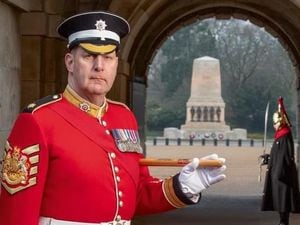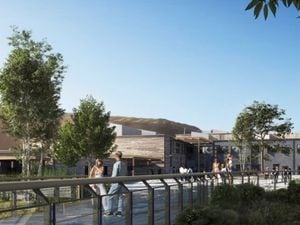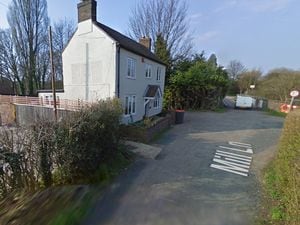When bombs fell on river town
A county man remembers when Luftwaffe raids struck his parents' hotel in Bridgnorth. Toby Neal meets 74-year-old Ken Ritchie.

At around 1.30am seven-year-old Ken Ritchie of Bridgnorth was woken by a whistling sound and moments later was blown out of bed by a huge German bomb which devastated his home.
Ken, who is now 74 and still lives in the town, had nearly become a victim of the blitz on Bridgnorth in August 1940.
In a recent feature in the Shropshire Star Mr Bill Moody, who was brought up as a child in Shrewsbury, told of one raid on the county town in October 1940. We had asked for others with memories of bombings in Shropshire to come forward.
Bridgnorth is unique in Shropshire in having a bomb site which has been turned into a memorial garden dedicated to the victims of the bombing of the town in the early hours of August 29, 1940. Two people died.
 Ken's parents Jack and Hilda Ritchie were the licensees of the Squirrel Hotel in Pound Street, Bridgnorth.
Ken's parents Jack and Hilda Ritchie were the licensees of the Squirrel Hotel in Pound Street, Bridgnorth.
"For about a week beforehand the siren went every night and we went down the cellar. This particular night my dad said 'We won't go down the cellar tonight. They're not going to bomb Bridgnorth.' But they did," recalls Ken.
He slept in the same room as his mum and dad, at the back of the hotel, which turned out to be fortunate.
"About 1.30am I was wakened by a whistling sound. That was it then. I must have been blown out of bed and hit the wall the other side of the room. The next thing I remember was being carried downstairs by my mum in her arms.
"It blew all of the front of the pub away. All the doors were blown off. There was glass everywhere. My sister Lorna was away on a week's holiday at the time. All the ceiling fell down in her bedroom on to her bed. She would probably have been killed.
"The Air Raid Precautions rescuers said that if we had gone down the cellar we would have been killed, as the blast went straight through it, blowing off the cellar flaps."
Ken was unscathed and said his mother had only cut her feet through the broken glass. His father had been out on ARP duty when the bomb struck.
While there were no fatalities at the Squirrel, other parts of the town were not so lucky.
"Two women were killed by direct hits on houses in Church Street and one behind the old St Leonard's rectory, which is now a dentist. Two or three incendiary bombs fell behind shops in the High Street.
 "There were 12 bombs altogether, but the biggest bomb was the one dropped outside the Squirrel, on the junction of St Mary's Street and Listley Street. It made a massive crater.
"There were 12 bombs altogether, but the biggest bomb was the one dropped outside the Squirrel, on the junction of St Mary's Street and Listley Street. It made a massive crater.
"It was the biggest bomb they had at that time. We had to go and live at my auntie and uncle's pub, the Three Horseshoes at Wheathill, while they rebuilt the pub."
He said that Mr Payne's sweet shop on the other side of the junction was also blown up by the same bomb.
The effects on Ken were to be long lasting.
"Every time an aircraft went over I had to get under the bed. I don't like hearing one even now."
The rebuilt Squirrel no longer exists, having been demolished in 1979.
Our feature also prompted a response from Lawrence Hatfield, of Shrewsbury, who said: "Your article on the bomb that hit Crewe Bank, Shrewsbury, brought back memories of my mother May Hatfield, who was living at 28 St Michael's Street at the time.
"She told me of the day it occurred. Her sister Alice, who was in the WRAC, had walked through Shrewsbury to visit her and had spotted the German plane flying around the area. She had just knocked on the front door, which my mother answered, when the plane flew down and dropped its bomb.
"She recalled the house shook and they both dived under the table, together with
my sister Margaret - aged two - thinking more bombs would follow. She always said that there was usually a gang of 'kids' playing outside in the area of Crewe Bank and that it was an act of God that there had been a shower of rain, which had caused the 'kids' to come in to their respective houses.
"I was born after the war on my father's return from war service. His name was Percy Hatfield. My sister is still alive and lives in Lowestoft and I am still resident in Sundorne, Shrewsbury."
 This map, published in 1950 to mark the tenth anniversary of the bombing,
This map, published in 1950 to mark the tenth anniversary of the bombing,
shows the location of bomb hits on Bridgnorth
Newspaper published list of targets
More bombs fell on Shropshire than you might think. In October 1944, the Shrewsbury Chronicle published a list of places on which bombs had fallen in 1940 alone, although it was not complete even then. In particular, no military damage was included.
Here are just a few "highlights":
June 26, five bombs at Shawbury, causing damage but no casualties; August 25, cottage damaged near Newcastle-on-Clun; August 29, two killed and seven injured in Bridgnorth; August 30, high explosive bomb in Sambrook did not go off but forced village inn to be closed until UXB blown up by Army; August 31, three killed in Shrewsbury.
September 5, Bishop's Castle fire brigade bombed while fighting a fire at Churchstoke; September 15, all windows blown out of Lady Stanier's house, The Citadel, Hawkstone; night of September 28, bomb made large crater on Lilleshall golf course at spot where the committee had met a few hours before to discuss the construction of bunkers.
Shrewsbury bombed October 10; early on morning of October 16 raider machine-gunned goods train near Yockleton, shooting off tail lamp on guards van; 16 HE bombs fell near Longnor October 22 - "as evidence of this incident a huge and perfectly round crater remains between the Caradoc and Little Caradoc."
One of the few instances of daylight bombing took place October 26, when Allscott sugar beet factory was damaged; bombs at Ironbridge on November 9 put an end to mayor-making proceedings in Much Wenlock. Town clerk's house was one of those damaged.
German bomber came down at Monkhopton night of November 15.
Night of most widespread activity over county was November 28 when estimated over 100 incendiary bombs, 27 HE bombs, and eight parachute mines dropped. Among many incidents, five houses damaged at Cruckmoor Lane, Prees Lower Heath, and Tugford Church and three nearby cottages damaged.
Evening of December 2, bomb in Berwick Road, Shrewsbury, made large crater into which woman motorist afterwards drove her car.





